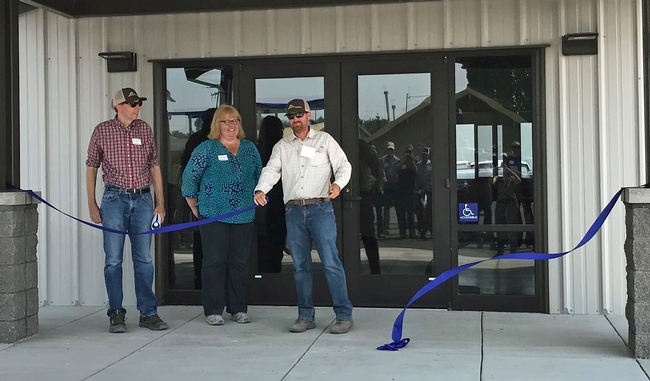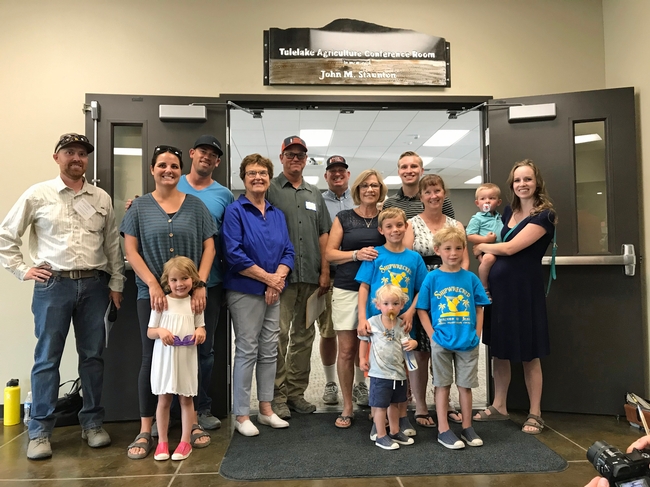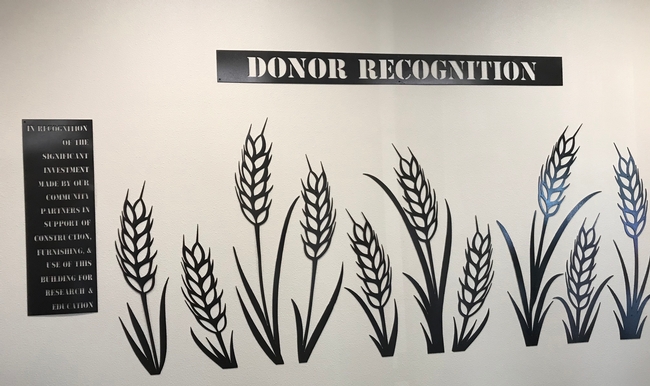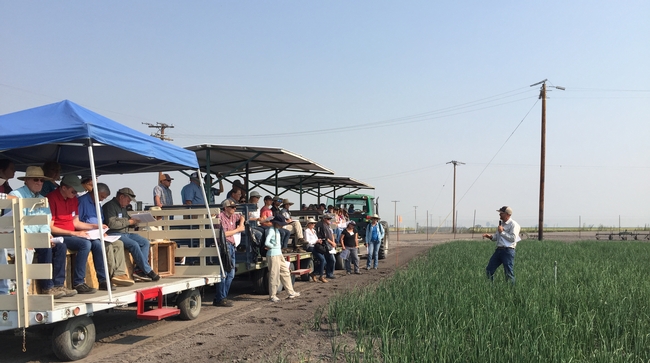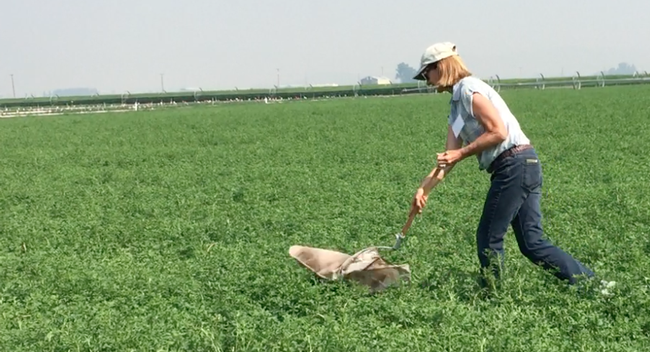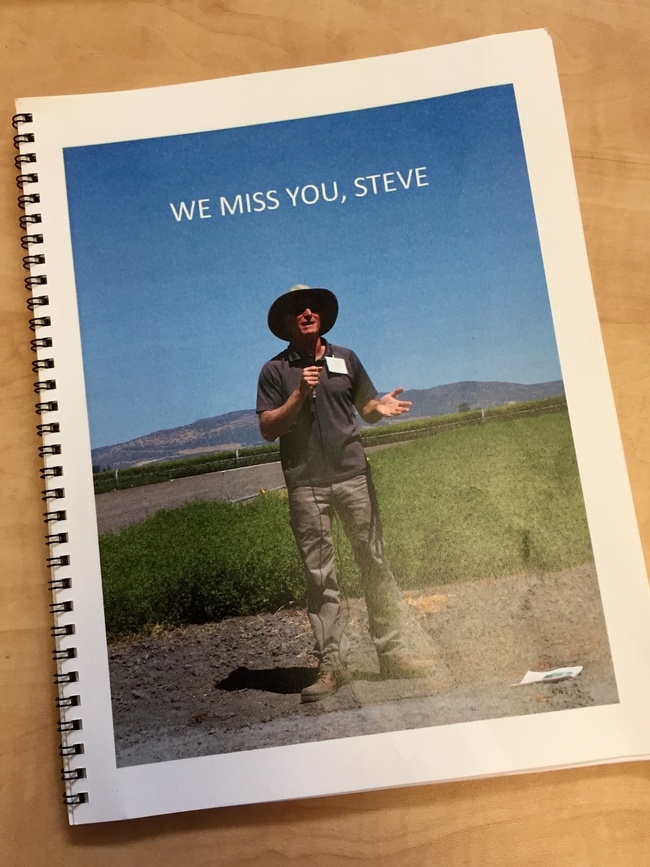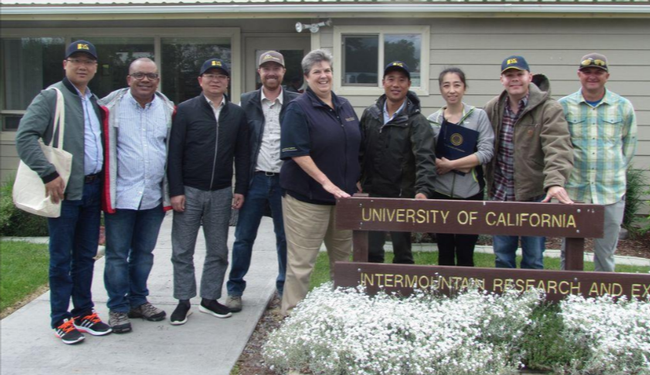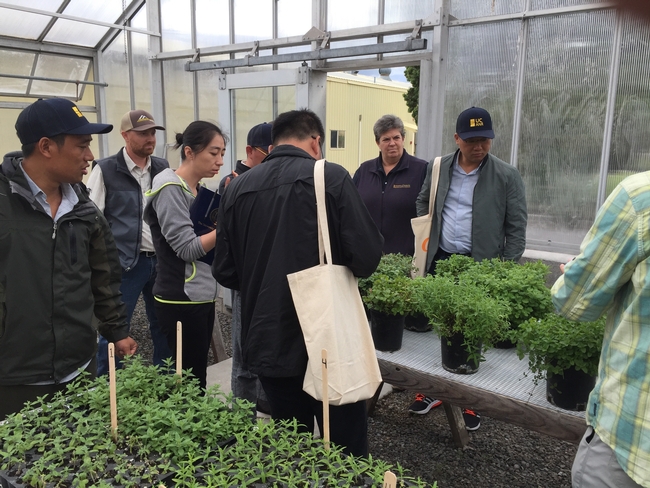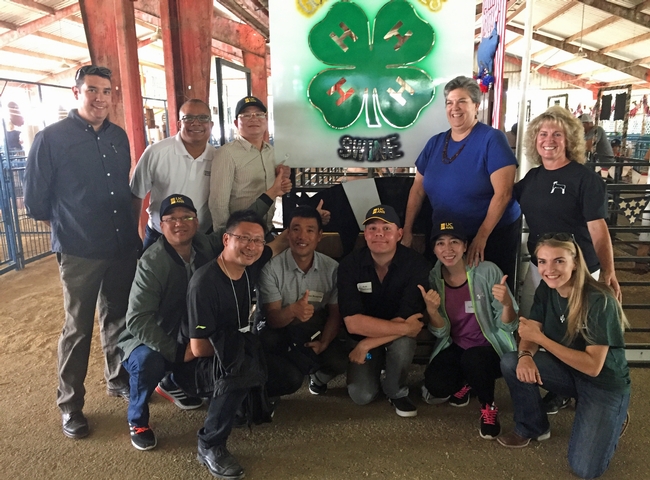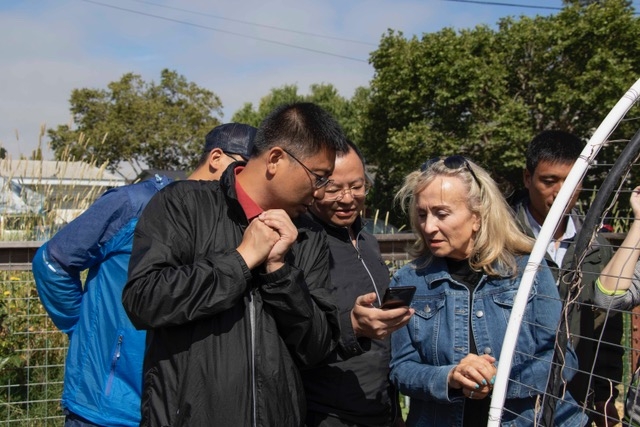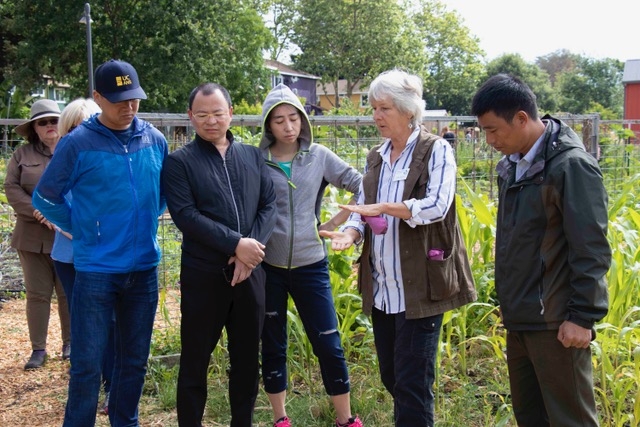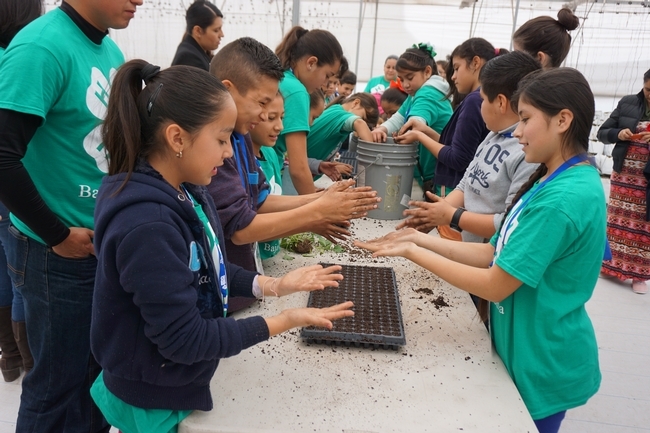Posts Tagged: Rob Wilson
Intermountain REC brings state-of-the-art conferencing to Tulelake
Intermountain Research and Extension Center (IREC) celebrated the grand opening of a multipurpose conference and laboratory building on July 26. The facility will be available for use by private and public groups for business meetings, job fairs, trainings and conferences.
"The facility is the first in the Tulelake area to offer modern audio-visual infrastructure and high-speed internet connectivity capable of supporting remote presentations to stay in touch with groups from around the world," said Rob Wilson, IREC director. "We hope this facility will greatly increase the visibility and accessibility of local events and help draw more regional attention to the area."
The conference room was dedicated in honor of the late John Staunton, a local research collaborator with UC Agriculture and Natural Resources who passed away in 2015. Staunton Farms and the Staunton family donated $25,000 to support the building project and recognize the Tulelake farmer and his long-standing support of agriculture and research.
Winema Elevators/Western Milling, Sensient Natural Ingredients, Macy's Flying Service, and Basin Fertilizer also contributed support.
UC awarded approximately $2 million for this capital improvement project with funds from UC lease revenue bonds to pay for most of the building's design and construction costs, but additional support is needed to complete the project. Intermountain REC has set a fundraising goal of $100,000 to pay for tables, chairs, furnishing and lab equipment for the building.
A special UC fund has been created to collect tax-deductible contributions to be used solely for this building project. Donations over $50 will receive recognition in print and on the IREC website. Donations over $1,000 will receive recognition on the donor wall in the building entryway. Name plate recognition on the donor wall will be based on the gift amount: Gold ($2,500+), Silver ($1,750 to $2,499), and Bronze ($1,000 to $1,749). Donations can be made via check using the enclosed envelope or by credit card by visiting the IREC website at http://irec.ucanr.edu and clicking the “Make a gift” link.
The ribbon cutting followed the 2018 IREC field day, an annual event that showcases the research underway at the 140-acre facility. Charlie Pickett of USDA, UC Davis Plant Breeding Center director Charlie Brummer, UCCE farm advisors David Lile and Rachael Long and UCCE specialist Dan Putnam joined Wilson in giving research updates on the tour.
Research presentations included work on biological control of cereal leaf beetle, influence of fall harvest management of irrigated grass hays, onion white rot, managing alfalfa weevil and clover rootcucurlio, pulse crop options for theKlamath Basin, cover crops and amendments, cutting schedule effects on lowlignin alfalfa andgermplasm evaluation of alfalfa and tallfescue.
Reporter Danielle Jester, who covered the events for the Siskiyou Daily News, noted the palpable absence of the late Steve Orloff, who was a UCCE farm advisor for Siskiyou County for 25 years. “Orloff's absence was noticeably felt throughout the day,” she wrote. “He passed away in October of 2017, and his influence in Siskiyou County's ag industry was very apparent, evidenced in part by the many mentions of his name and work throughout the day. IREC paid tribute to Orloff in the final page of its field day guide, which featured a full-page image of Orloff during a previous field day, with the words, ‘We miss you, Steve.'”
In the news article, Jester also wrote, “The information gleaned through research at the IREC can be invaluable to farmers and other researchers. Through its years of experimentation, the center has helped growers develop more effective practices in a wide range of areas, from determining the crops that will grow best in the local climate, to selecting the most economically viable crops for the region, to understanding the most effective ways to manage pests and disease.”
Chinese scientists tour California agriculture with UC ANR
To promote the exchange and sharing of agricultural extension information, several U.S. Land Grant institutions have formed an alliance with 10 Chinese agricultural universities. From June 17 to 22, UC ANR took a group of scientists from Chinese agricultural universities on a tour of agriculture in Northern California.
“The Chinese face many of the same issues that we do here in the U.S.,” said VP Glenda Humiston. “The Chinese universities want to improve rural economic development to lift up the quality of life for people in rural communities. They are also responding to global climate change, drought and pests while trying to improve food security and water use efficiency. They see UC Cooperative Extension as an effective research model; we hope that scientific collaborations will accelerate solutions and help maintain relations for California agriculture with China.”
The Chinese Extension Alliance Delegation included Song Hui, vice dean of the New Rural Development Research Institute of Northeast Agricultural University; Sun Wenpeng, professional extension personnel of Northeast Agricultural University; Luo Jian, associate professor of business at Hunan Agricultural University; He Minghui, associate professor of business at Hunan Agricultural University; and Li Peng, director of the Office of Invigorating Agriculture with Science and Education in the Department of Science and Technology.
The group toured Oregon agriculture with Oregon State University representatives, then drove from Klamath Falls with Humiston and Greg Gibbs and Rob Broadhurst of Development Services to begin the California tour at UC ANR's Intermountain Research and Extension Center in Tulelake. Rob Wilson, Intermountain REC director, showed them research being conducted on potatoes and mint breeding. From there, the group headed out to tour Shasta Dam.
In Redding, Larry Forero, UCCE director in Shasta County, and Rick Satomi, UCCE forest advisor, told the Chinese delegates about local research and outreach, then introduced them to 4-H youth and families at the Shasta District Fair, where 4-H members were bringing livestock for show.
UCCE advisors Josh Davy and Allan Fulton discussed orchards and water in Tehama County.
In Yuba City, UCCE director Janine Hasey and her staff gave the guests an overview of UCCE programs in Yuba and Sutter counties and plans for celebrating the office's 100th anniversary on Aug. 24. They met with UCCE pomology advisors, who gave them a tour of Sierra Gold Nurseries orchards and walnut rootstock research sites and discussed collaborations with growers.
Stephanie Larson, UCCE director in Sonoma County, drove the group around areas in Santa Rosa that burned in October and discussed UCCE's fire research and outreach to the community. The group also met with UCCE staff in Sonoma County to discuss food access, 4-H youth development, natural resources and wine grapes.
For a view of UC Cooperative Extension from the campus perspective, Mark Bell, vice provost of Strategic Initiatives and Statewide Programs, introduced the group to colleagues in the College of Agricultural & Environmental Sciences at UC Davis. They met with Mimi Rose, program coordinator for international programs; Martin Smith, UCCE specialist in the Department of Human Ecology; Ron Tjeerdema, associate dean for Environmental Sciences; Bruce Linquist, UCCE rice specialist; Jim Hill, emeritus UCCE specialist; and Louise Ferguson, UCCE specialist and founder of the Fruit and Nut Research and Information Center.
Anne Megaro, director of governmental and community relations, introduced the group to Gail Feenstra, deputy director and food systems coordinator of UC ANR's Sustainable Agriculture Research and Education Program, and Sonja Brodt, academic coordinator. Then they toured the Russell Ranch Sustainable Agriculture Facility with soil science post-doc Daoyuan Wang and the UC Davis Student Farm with its director Katharina Ullmann.
“They have extension in China, but it is not like ours,” said Megaro. “They are looking to strengthen their advisor positions and develop a mechanism for career advancement, similar to what we have in the U.S.”
The Chinese Extension Alliance Delegation wrapped up their tour at UC ANR's offices in Davis to learn about UC ANR's statewide programs. Jim Farrar discussed the Statewide Integrated Pest Management Program, Missy Gable described the Master Gardener Program, Shannon Horrillo talked about the 4-H youth development program, Greg Ira explained California Naturalist; and Katie Panarella covered the Nutrition, Family and Consumer Sciences, Expanded Food Nutrition Education (EFNEP) and Master Food Preserver programs.
Humiston, who met with the China-US University-based Agricultural Extension Alliance in China in March of 2017, said, “We look forward to collaborating with our agricultural extension colleagues in China.”
See more photos of the tour at https://www.flickr.com/gp/151501801@N07/YVBqk6.
AVP Powers announces 51 proposals invited for competitive and high-reward grants
AVP Wendy Powers announced the letters of intent (LOIs) for which principal investigators have been invited to submit full proposals to ANR's Competitive Grants Program and High-Risk/High-Reward Grants Program. The list of 51 approved projects can be found at http://ucanr.edu/sites/anrstaff/files/261626.pdf.
This year ANR received a total of 108 letters of intent — 97 for the Competitive Grants Program and 11 for the High-Risk/High-Reward Grants Program. Strategic Initiative leaders and their respective panels reviewed all letters of intent thoroughly to address the appropriateness of the proposals in addressing the goals and criteria outlined by each funding opportunity.
ANR Competitive Grants Program
The purpose of the ANR competitive grants program is to address high-priority issue areas identified by at least one of the strategic initiatives: Endemic and Invasive Pests and Diseases (EIPD), Healthy Families and Communities (HFC), Sustainable Food Systems (SFS), Sustainable Natural Ecosystems (SNE), and Water Quality, Quantity and Security (Water).
ANR Competitive Grants Program 2017 Cycle:
- Full proposals due June 19
- Technical peer review: mid-June – early September 2017
- Strategic Initiative review and recommendations: end of September 2017
- Program Council review and recommendations: October/November 2017
- Announcement of funded grants: November/December 2017
High-Risk/High-Reward Grants Program
Given the complexity of societal problems, high-risk research is necessary to achieve gains for real progress in addressing present and emerging challenges. This program will provide funds to initiate and complete research and proof-of-concept efforts that serve as the basis for larger funding opportunities. These projects must be of a high-risk/high-reward nature that are best conducted in a controlled, research setting and, if successful, lend themselves to subsequent larger funding opportunities and/or intellectual property development.
Proposed projects must be within the scope of the ANR Strategic Vision. All ANR academics with PI status are eligible to apply. Proposals will be accepted using the same timeline as outlined for the traditional competitive grants program, but reviewed separately due to the nature of the proposal.
For questions about ANR's competitive grants program or high-risk/high-reward grants program, please contact Melanie Caruso at mmcaruso@ucanr.edu.
Nutrition Policy Institute launches Research to Action news brief
The Nutrition Policy Institute has launched a news brief called Research to Action. The publication will provide information on research, policy, news, announcements, events, articles and action items focused on nutrition and healthy communities.
The first issue looks at the work of the National Drinking Water Alliance (NDWA). NPI is the “hub” for NDWA, which engages in and coordinates evidence-based efforts going on all over the country to improve tap water safety and access, especially for children, and to provide drinking water education and promotion. The NDWA website is a “go-to” resource for information on drinking water.
Future editions of Research to Action will be sent several times per year. Please sign up for the Research to Action mailing list, and please share Research to Action with colleagues who would be interested in receiving it.
4-H calls alumni and friends to join its new network
If 4-H has touched your life, raise your hand. Visit http://4-H.org/raiseyourhand to voice your support for the California 4-H youth development program, help it win a national competition and connect with a network of 4-H alumni and friends.
You are considered alumni if you were in a 4-H Club, took part in a 4-H after-school program, served as a volunteer leader or taught a project. Friends of 4-H are also invited to raise their hands.
“Having experienced our programs first-hand, our alumni know about the positive impact of 4-H,” said Glenda Humiston, vice president of UC Agriculture and Natural Resources and a 4-H alumna.
As part of the new 4-H network being built in the 4-H Raise Your Hand campaign, members will get news about 4-H programs in California and stay in touch with a program that made a difference in their lives.
“I've raised my hand,” said Humiston, who credits 4-H with helping her become the first in her family to attend college. She later served in the Peace Corps, received a federal appointment from President Obama and now leads the statewide research and outreach arm of UC.
The National 4-H program, which currently empowers nearly 6 million youth across the country, aims to extend its reach to 10 million by 2025. It has launched a competition among states to see which ones can add the most alumni and friends to the network by June 30, 2017. A map showing the current front runners is on the registration page.

